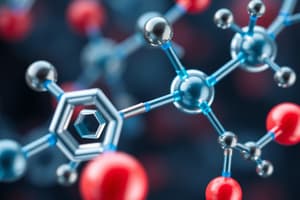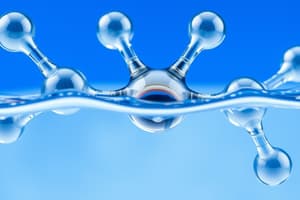Podcast
Questions and Answers
What type of bond is formed when electrons are shared between two atoms?
What type of bond is formed when electrons are shared between two atoms?
- Free radical bond
- Covalent bond (correct)
- Ionic bond
- Hydrogen bond
A decomposition reaction involves the combining of two or more molecules to form a larger molecule.
A decomposition reaction involves the combining of two or more molecules to form a larger molecule.
False (B)
What is the primary difference between potential and kinetic energy?
What is the primary difference between potential and kinetic energy?
Potential energy is stored energy due to position, while kinetic energy is the energy of motion.
A molecule with an unpaired electron in its outermost shell is called a _________.
A molecule with an unpaired electron in its outermost shell is called a _________.
Match the following terms with their definitions:
Match the following terms with their definitions:
Which of the following elements make up 96% of the body's mass?
Which of the following elements make up 96% of the body's mass?
A molecule consists of one atom.
A molecule consists of one atom.
What is the smallest unit of matter that retains the properties of a chemical element?
What is the smallest unit of matter that retains the properties of a chemical element?
A(n) ________ is a substance containing atoms of two or more different elements.
A(n) ________ is a substance containing atoms of two or more different elements.
Which of these is NOT a basic part of an atom?
Which of these is NOT a basic part of an atom?
A free radical has a paired electron in its outermost shell.
A free radical has a paired electron in its outermost shell.
What is the atomic number of an atom defined by?
What is the atomic number of an atom defined by?
Which of the following is NOT a critical property of water for sustaining organisms?
Which of the following is NOT a critical property of water for sustaining organisms?
Acids release hydroxyl ions (OH–) into solution.
Acids release hydroxyl ions (OH–) into solution.
What is the purpose of buffers in the body?
What is the purpose of buffers in the body?
What are the products of the reaction when sucrose and water interact?
What are the products of the reaction when sucrose and water interact?
RNA uses the nucleotide base Thymine.
RNA uses the nucleotide base Thymine.
A neutralization reaction occurs when acids and bases react to form water and a ______.
A neutralization reaction occurs when acids and bases react to form water and a ______.
Match the following terms with their correct descriptions:
Match the following terms with their correct descriptions:
What is the main function of ATP?
What is the main function of ATP?
Inorganic compounds typically lack the element ________.
Inorganic compounds typically lack the element ________.
Which of these is NOT a major type of lipid in the human body?
Which of these is NOT a major type of lipid in the human body?
Denatured proteins are more functional than their original state.
Denatured proteins are more functional than their original state.
What is the most abundant substance in the body and also an excellent solvent?
What is the most abundant substance in the body and also an excellent solvent?
A pH of 9 indicates an acidic solution.
A pH of 9 indicates an acidic solution.
What is the name of the specific part of an enzyme that catalyzes a reaction?
What is the name of the specific part of an enzyme that catalyzes a reaction?
Carbohydrates are synthesized through ________ reactions.
Carbohydrates are synthesized through ________ reactions.
Match the following nucleotide bases with their respective nucleic acids:
Match the following nucleotide bases with their respective nucleic acids:
Which of the following is NOT a function of proteins in the body?
Which of the following is NOT a function of proteins in the body?
Hydrolysis is the process of building large molecules from smaller ones by adding water.
Hydrolysis is the process of building large molecules from smaller ones by adding water.
Adenosine triphosphate, also known as ____ , is the main energy-transferring molecule in living systems.
Adenosine triphosphate, also known as ____ , is the main energy-transferring molecule in living systems.
Match the following molecules with their primary function:
Match the following molecules with their primary function:
Flashcards
Covalent bond
Covalent bond
Atoms joined by shared electrons.
Potential energy
Potential energy
Energy stored in the position or structure of matter.
Energy
Energy
The capacity to do work.
Synthesis reaction
Synthesis reaction
Signup and view all the flashcards
Decomposition reaction
Decomposition reaction
Signup and view all the flashcards
Chemical Elements
Chemical Elements
Signup and view all the flashcards
Atoms
Atoms
Signup and view all the flashcards
Atomic Number
Atomic Number
Signup and view all the flashcards
Mass Number
Mass Number
Signup and view all the flashcards
Ions
Ions
Signup and view all the flashcards
Molecules
Molecules
Signup and view all the flashcards
Compounds
Compounds
Signup and view all the flashcards
Synthesis
Synthesis
Signup and view all the flashcards
Hydrolysis
Hydrolysis
Signup and view all the flashcards
Triglycerides
Triglycerides
Signup and view all the flashcards
Phospholipids
Phospholipids
Signup and view all the flashcards
ATP
ATP
Signup and view all the flashcards
RNA
RNA
Signup and view all the flashcards
Water as a Solvent
Water as a Solvent
Signup and view all the flashcards
Water's Heat Capacity
Water's Heat Capacity
Signup and view all the flashcards
Acids
Acids
Signup and view all the flashcards
Bases
Bases
Signup and view all the flashcards
Neutralization
Neutralization
Signup and view all the flashcards
Salts
Salts
Signup and view all the flashcards
Buffers
Buffers
Signup and view all the flashcards
Carbohydrates
Carbohydrates
Signup and view all the flashcards
What are substrates?
What are substrates?
Signup and view all the flashcards
What are products in a chemical reaction?
What are products in a chemical reaction?
Signup and view all the flashcards
What is dehydration synthesis?
What is dehydration synthesis?
Signup and view all the flashcards
What are the three main types of nucleic acids?
What are the three main types of nucleic acids?
Signup and view all the flashcards
What are the four bases in DNA?
What are the four bases in DNA?
Signup and view all the flashcards
What are the four bases in RNA?
What are the four bases in RNA?
Signup and view all the flashcards
What is pH?
What is pH?
Signup and view all the flashcards
What are buffer systems?
What are buffer systems?
Signup and view all the flashcards
Study Notes
Chapter 2: Basic Chemistry
- A humorous image displays a frustrated cat, referencing a chemistry joke about nitric oxide and the element Argon
Introduction to Chemistry—Chemical Elements and Atoms
- Atoms are made up of chemical elements, which cannot be further broken down by usual chemical means.
- Each element has a designated chemical symbol.
Main Chemical Elements in the Body
- Oxygen (O), carbon (C), hydrogen (H), and nitrogen (N) make up about 96% of the body's mass.
- Oxygen is part of water and many organic molecules and is used to generate ATP.
- Carbon creates the backbone in many organic molecules such as carbohydrates, lipids, proteins and nucleic acids.
- Hydrogen is a constituent of water and most organic molecules.
- Nitrogen is a component of proteins and nucleic acids.
Chemical Elements and Atoms
- Each element is composed of atoms, the smallest structural unit that retains properties of the element.
- Atoms have two basic parts: a nucleus (protons and neutrons), and one or more electrons.
Atomic Structures
- Atomic number equals the number of protons in an atom
- Mass number equals the number of protons plus neutrons in an atom.
Molecules, Molecules, and Compounds
- A molecule consists of two or more atoms sharing electrons.
- A molecular formula shows the number and type of atoms in a molecule.
- A compound comprises atoms of two or more different elements.
- A free radical is an ion or molecule with an unpaired electron in its outer shell.
Molecules
- Two hydrogen molecules (2 H₂) plus one oxygen molecule (O₂) combine to form two water molecules (2 H₂O).
Chemical Bonds—Ions and Ionic Bonds
- Ionic bonds form when outer shell electrons transfer from one atom to another, creating ions with opposite charges.
- Ionic bonds occur between ions with opposite charges.
Chemical Bonds—Covalent Bonds
- Polar covalent bonds between hydrogen and other atoms can form hydrogen bonds.
- Hydrogen bonds are weak bonds between hydrogen and other atoms.
Chemical Reactions
- Chemical reactions either combine molecules (A+B=AB) or break them down (AB=A+B).
- Exchange reactions involve both synthesis and decomposition, which can proceed in both directions.
Chemical Reactions—Reversible Chemical Reactions
- Reversible reactions can progress in both directions under certain conditions.
Introduction to Chemistry
- Matter is composed of chemical elements.
- Elements like oxygen, carbon, hydrogen, and nitrogen are essential to the body, comprising 96% of the mass.
- Atoms are the fundamental building blocks of elements. Atoms contain a nucleus (protons and neutrons) and electrons surrounding the nucleus.
- The atomic number is the number of protons in an atom; its mass number is the total of protons and neutrons.
- An ion is an atom that has gained or lost electrons, causing a positive or negative charge.
Introduction to Chemistry
- A molecule is two or more chemically combined atoms.
- A compound consists of two or more elements chemically combined.
- Free radicals have unpaired electrons and can be destructive.
- Chemical bonds hold atoms together, with valence shell electrons playing a key role in chemical reactions.
Introduction to Chemistry
- Ionic bonds result from electron transfer between atoms, forming charged ions that attract.
- Covalent bonds involve sharing electron pairs between atoms.
- Hydrogen bonds are weak bonds between hydrogen and certain atoms.
- Energy is the ability to do work, including potential energy (stored) and kinetic energy (motion).
Introduction to Chemistry
- Synthesis reactions (anabolic) combine small molecules into larger molecules.
- Decomposition reactions (catabolic) break down large molecules into smaller molecules.
- Exchange reactions involve both synthesis and decomposition reactions to rearrange atoms.
- Many biochemical reactions can reverse.
Chemical Compounds and Life Processes
- Organic compounds are carbon-based molecules, including glucose.
- Inorganic compounds, such as water, typically lack carbon.
- The question is raised about the origin of carbon in organic compounds.
Inorganic Compounds—Water
- Water is an excellent solvent, participating in chemical reactions.
- Water has a crucial role in temperature regulation. Water acts as a lubricant.
Inorganic Compounds—Acids, Bases, and Salts
- Acids release hydrogen ions (H⁺) into solution.
- Bases release hydroxyl ions (OH⁻) into solution.
- Neutralization reactions occur when acids and bases combine to form water and a salt.
- Salts dissociate into ions in water and are vital in many bodily processes.
Inorganic Compounds—Acids, Bases, and Salts—Example
- HCl (hydrochloric acid) + KOH (potassium hydroxide) yields KCl (potassium chloride) + H₂O (water)
Inorganic Compounds—pH
- pH measures the hydrogen ion concentration in a substance.
- A neutral pH is 7. Lower values indicate acidity; higher values indicate alkalinity.
- Body fluids maintain a stable pH through buffer systems.
Inorganic Compounds—pH
- Various bodily fluids have specific pH ranges.
- These values indicate their acidity or alkalinity level.
Inorganic Compounds—Buffers
- Buffers are chemical compounds that act to quickly bind with and remove excess reactive hydrogen ions from bodily fluids.
- This prevents drastic changes in pH, which could be detrimental to biological function.
Organic Compounds—Carbohydrates
- Carbohydrates, encompassing sugars and starches, are categorized by size.
- Monosaccharides are simple sugars.
- Disaccharides are two simple sugars linked together.
- Polysaccharides are long-chain, branching structures formed by linked monosaccharides.
Carbohydrates—Monosaccharides
- Glucose, fructose, and galactose are example monosaccharides
- Dehydration reaction forms more complex sugars such as sucrose, lactose, and maltose, releasing water.
Carbohydrates—Polysaccharides
- Polysaccharides are long chains of glucose molecules, forming complex structures.
Organic Compounds—Lipids
- Lipids include neutral fats (triglycerides), phospholipids, and steroids.
- Triglycerides are stored fat deposits.
- Phospholipids form cellular membranes.
- Steroids are lipid-based hormones, cholesterol, bile salts, and vitamin D. - Examples of Lipids include palmitic acid, stearic acid, and oleic acid.
Triglycerides
- Triglycerides are formed from a glycerol molecule and three fatty acid molecules.
Phospholipids
- Phospholipids have a polar head and nonpolar tails.
- Phospholipids are crucial components of cell membranes.
Steroids
- Steroids, such as cholesterol and estradiol, have a complex structure involving four interconnected rings.
Organic Compounds—Proteins
- Proteins are chains of amino acids.
- Proteins perform diverse functions in the body, including enzymes, hormones, and antibodies.
- Denaturation occurs when proteins unravel and lose their structure due to environmental changes like heat, pH, or ion concentration.
Organic Compounds—Proteins
- Amino acids form the building blocks for proteins.
- Proteins have different functions in the cell, influencing many cell processes.
- Protein denaturation alters a protein's shape and affects its function.
Organic Compounds—Proteins: Enzyme Actions
- Enzymes are proteins that speed up chemical reactions by lowering activation energy.
- Substrates fit into an enzyme's active site to form an enzyme-substrate complex.
- Enzyme activity is affected by factors such as temperature and pH.
Organic Compounds—Nucleic Acids
- DNA is the genetic blueprint of life, composed of four nucleotide bases (adenine, guanine, cytosine, thymine).
- RNA is an intermediary between DNA and protein synthesis, composed of similar bases except uracil.
- Adenosine triphosphate (ATP) is the main energy currency of cells, storing and releasing energy as needed by cells to do work.
DNA
- DNA has a double helix structure, encoding genetic information.
ATP and ADP
- ATP is formed by adding a phosphate group to ADP to store energy.
- Breaking down ATP releases energy.
Chemical Compounds and Life Processes
- Inorganic compounds are chemically simple and don't contain carbon.
- Organic compounds contain carbon and have covalent bonds.
- Water is the primary component of the human body
- Various inorganic acids, bases, and salts dissociate into ions in water.
Chemical Compounds and Life Processes
- Body fluids maintain a constant pH.
- pH is a measure of acidity or alkalinity, with 7 being neutral.
- Buffers help regulate pH by converting strong acids or bases to weaker ones.
- Carbohydrates, like sugars, glycogen, and starches, are crucial sources of energy for the body.
Chemical Compounds and Life Processes
- Carbohydrates and other large organic molecules are synthesized via dehydration reactions and broken down by hydrolysis.
- Lipids including triglycerides, phospholipids and steroids perform diverse tasks in the body.
- Proteins are made of amino acids and are essential structural components and for performing functions such as transporting substances, contracting muscles, regulating processes and acting as enzymes.
Chemical Compounds and Life
- Enzymes, often proteins, are crucial for speeding up chemical reactions.
- DNA is crucial for genetic information, and RNA acts as a translator from DNA instructions into protein synthesis.
- ATP acts as the main energy-carrying molecule for all organisms converting and transmitting energy for cells to use.
Studying That Suits You
Use AI to generate personalized quizzes and flashcards to suit your learning preferences.
Related Documents
Description
Test your understanding of essential biological concepts related to chemical bonds, energy types, and atomic structure. This quiz will cover key terms, definitions, and the fundamental principles of chemistry as they pertain to biology. Prepare to match terms with their definitions and answer questions about molecules and elements.




